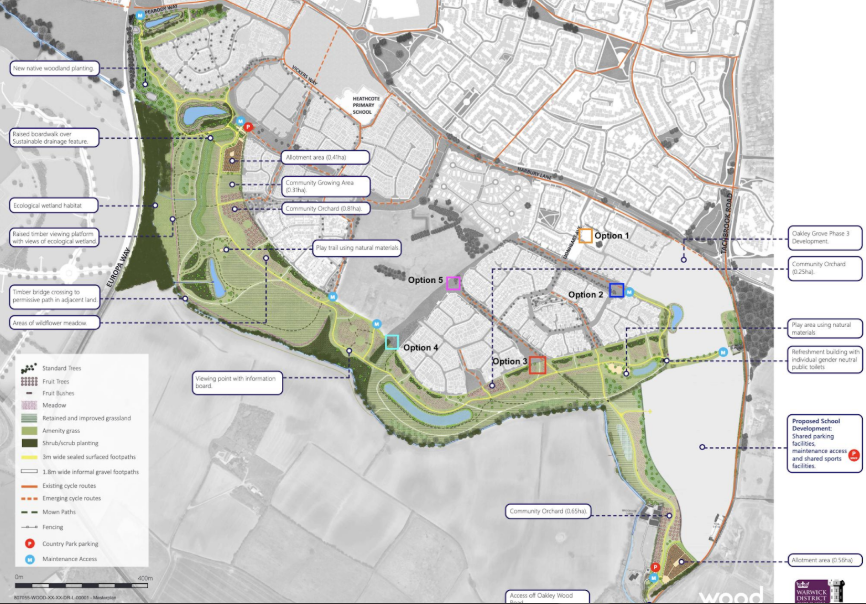
Selected survey responses and their location within 1km of a proposed site from the first test conducted in February 2024, a total of 66 responses were recorded out of 900 leaflets dropped. The results indicate that people living within 400 meters of a mentioned issue were much more likely to scan a QR code to find out more.
QR Code Effectiveness Tests
Finding: Hyperlocal QR code Calls to Action (CTAs) generated a scan rate of 7.7%. More than 90% of these scans were produced by QR CTAs pertaining to concrete community institutions, with substantial geographical clustering around points of interest. By contrast, CTAs pertaining to community newsletters and WhatsApp groups generated negligible engagement.
First test
Tests conducted in Warwickshire and Maidenhead examined how various factors influence QR code scan rates on political campaign materials. The more substantial Warwickshire test conducted in February 2024 distributed 900 leaflets across six neighbourhoods, featuring three different QR codes linking to a school petition, shop consultation, and newsletter signup.
Results revealed that hyperlocal relevance was the strongest driver of engagement. QR codes connected to the school and shop accounted for the vast majority of scans. The results also showed signs of substantial geographical clustering – 25 of 27 school petition scans came from households within 400 meters of the school, while 24 of 33 shop consultation scans originated within 100 meters of proposed sites. The newsletter signup performed poorly regardless of location, generating only 6 total scans.
The smaller Maidenhead test attempted to determine whether doorknocking improved scan rates versus regular leafleting, and whether front placement outperformed back placement. However, with only 4 total scans across 390 distributed materials, the data was insufficient to draw meaningful conclusions. Overall, these tests suggest QR CTAs should be hyperlocal and concrete, pertaining to community institutions – like schools and shops – rather than political engagement mechanisms such as newsletters.
| Road Group | Number of leaflets distributed | QR Code front scans (school petition) | QR Code back scans (new shop consultation) | QR Code scans back (substack sign up) |
|---|---|---|---|---|
| Orton | 150 | 9 | 3 | 0 |
| Jakeman | 150 | 10 | 5 | 5 |
| Peabody | 150 | 4 | 1 | 0 |
| Wesson | 150 | 2 | 0 | 0 |
| Trebell Way | 150 | 1 | 11 | 1 |
| Lionheart (North) | 150 | 1 | 13 | 0 |
| Total | 900 | 27 | 33 | 6 |
| QR Code front scans (school petition) | QR Code back scans (new shop consultation) | QR Code scans back (substack sign up) | Total |
| 14 | 3 | 4 | 21 |
| 7 | 4 | 1 | 12 |
| 2 | 0 | 0 | 2 |
| 1 | 14 | 1 | 16 |
| 2 | 2 | 0 | 4 |
| 1 | 5 | 0 | 6 |
| 0 | 5 | 0 | 5 |
| 27 | 33 | 6 | 66 |
Second test
The second test implemented during the Warwickshire by-election in January 2025 and sought to establish to what extent QR code CTAs relating to political contact mechanisms were effective in generating engagement. We tested a leaflet with two QR CTAs – one to book a call with a council candidate, the other to join a community WhatsApp group.
Overall engagement rates remain extremely low across both CTAs. The Warwickshire by-election showed only 25 individual QR code scans from 3,500 distributed leaflets (0.7% scan rate), with just 7 actual constituent form completions (0.2% conversion rate). Hyperlocal action-oriented codes (petitions, consultations) consistently outperformed informational ones like newsletter signups.
For campaigns considering QR codes, we recommend a focus on extremely local issues alongside action-oriented calls-to-action that pertain to concrete community institutions, rather than general interest issues or political engagement mechanisms.
Warwickshire 2025: https://docs.google.com/document/d/1TW6-s8hbf66rgzCEjrUUF_SN_weVlrTBY6Ys6ANJTuM/edit?tab=t.0#heading=h.ofnn87dlb9j3
